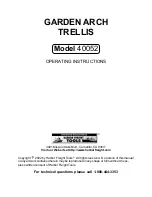
UltiMate 3000 Series:
AFC-3000 Automated Fraction Collector
Operating Instructions
Page
5
•
Capillaries, capillary connections, open connections
♦
Capillaries, especially non-metallic capillaries may burst, slip out of their fittings or
may not be screwed in. This may result in substances spraying out of the open
connections.
♦
In an UltiMate 3000 system, some components are made of PEEK™. This polymer
has superb chemical resistance to most organic solvents. However, it tends to swell
when in contact with trichlormethane (CHCl
3
), dimethyl sulfoxide (DMSO), or
tetrahydrofuran (THF). In addition, it is attacked by concentrated acids, such as,
sulfuric acid and nitric acid or a mixture of hexane, ethyl acetate, and methanol. In
both cases, capillaries may start leaking or they can burst. Swelling or attack by
concentrated acids is not a problem with brief flushing procedures.
♦
Do not use tubing that is stressed, bent, kinked, or damaged.
♦
Capillary connections can be contaminated by harmful substances or harmful
substances can escape from open connections.
♦
Always wear safety glasses when handling fused silica tubing, for example, during
installation or when cutting capillaries to the length.
•
Disconnect the fraction collector from all power sources before removing the panels.
When the panels are removed, dangerous electrical connections will be exposed. The
enclosure must be opened only by Thermo Fisher Scientific service personnel.
•
Replace faulty communication cables.
•
Replace faulty power cords. Never use a power cord other than the power cords provided
for the device.
•
Use only the original spare parts and accessories authorized for the device by Thermo
Fisher Scientific.
•
When operating the HPLC system, always set a lower pressure limit for the pump. This
prevents damage resulting from leakage or from running the pump dry.
•
The fraction collector weighs more than 8 kg (17.7 lbs). Therefore, you should use
caution when lifting or moving the fraction collector.
•
When lifting or moving the autosampler, always lift by the bottom or sides of the unit.
This is to avoid damage to the instrument.
•
After operation, rinse out buffers and solutions that form peroxides.
•
Before switching from buffer to organic solution, rinse the analytical system thoroughly
with deionized or HPLC grade water.
•
When switching to another solvent, ensure that the new solvent is miscible with the one
contained in the HPLC system. If the solvents are not miscible, the system can be
damaged, for example, by flocculation.
Содержание AFC-3000
Страница 2: ...UltiMate 3000 Series AFC 3000 Automated Fraction Collector Operating Instructions ...
Страница 4: ...UltiMate 3000 Series AFC 3000 Automated Fraction Collector Page II Operating Instructions ...
Страница 18: ...UltiMate 3000 Series AFC 3000 Automated Fraction Collector Page 12 Operating Instructions ...
Страница 28: ...UltiMate 3000 Series AFC 3000 Automated Fraction Collector Page 22 Operating Instructions ...
Страница 48: ...UltiMate 3000 Series AFC 3000 Automated Fraction Collector Page 42 Operating Instructions ...
Страница 76: ...UltiMate 3000 Series AFC 3000 Automated Fraction Collector Page 70 Operating Instructions ...
Страница 78: ...UltiMate 3000 Series AFC 3000 Automated Fraction Collector Page 72 Operating Instructions ...
Страница 82: ...UltiMate 3000 Series AFC 3000 Automated Fraction Collector Page 76 Operating Instructions ...
Страница 86: ...UltiMate 3000 Series AFC 3000 Automated Fraction Collector Page 80 Operating Instructions Sample run ends here ...












































